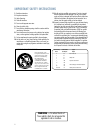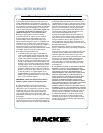7
•
Position the full-range loudspeakers so the high-
frequency drivers are 2 to 4 feet above ear level
for the
audience (make allowances for a standing/
dancing in the aisles audience). High frequencies
are highly directional and tend to be absorbed
much easier than lower frequencies. By providing
direct line-of-sight from the loudspeakers to the
audience, you increase the overall brightness and
intelligibility of the sound system.
•
Highly reverberant rooms, like many gymnasiums
and auditoriums, are a nightmare for sound system
intelligibility. Multiple refl ections off the hard walls,
ceiling, and fl oor play havoc with the sound. Depend-
ing on the situation, you may be able to take some
steps to minimize the refl ections, such as putting
carpeting on the fl oors, closing draperies to cover
large glass windows, or hanging tapestries or other
materials on the walls to absorb some of the sound.
However, in most cases, these remedies are not
possible or practical. So what do you do? Making
the sound system louder generally doesn’t work
because the refl ections become louder, too. The
best approach is to provide as much direct sound
coverage to the audience as possible. The farther
away you are from the speaker, the more prominent
will be the refl ected sound.
Use more speakers strategically placed so they are
closer to the back of the audience. If the distance
between the front and back speakers is more than
about 100 feet, you should use a delay processor to
time-align the sound. (Since sound travels about 1
foot per millisecond, it takes about 1/10 of a second
to travel 100 feet.)














